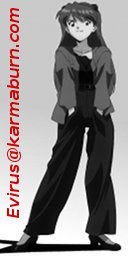|
|
Blog Archives:
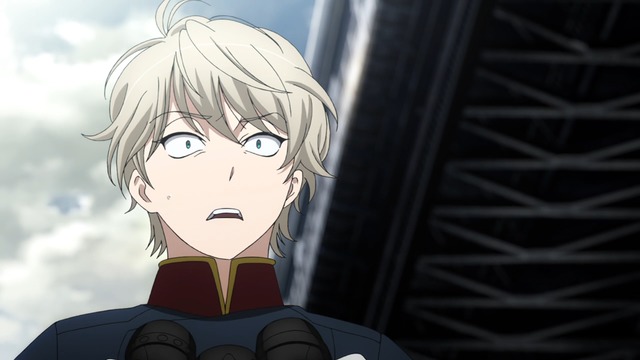
Slaine has seen some shit.
Aldnoah.Zero was far and away the best show from Summer 2014. I know a lot of viewers disagree with this opinion, but I thoroughly enjoyed all of its episodes. I've written a lot about it. Probably too much, considering I don't like it thaaat much even though it did almost get a perfect score on my little chart jobbie.
(more…)
Posted in Akame ga KILL!, Aldnoah.Zero, Barakamon, BEST GIRL, Bishoujo Senshi Sailor Moon Crystal, Detective Conan, Fate/kaleid liner Prisma☆Illya, Gekkan Shoujo Nozaki-kun, HappinessCharge Precure!, JoJo's Bizarre Adventure, Rail Wars!, Rokujouma no Shinryakusha!?, Sabagebu!, Season Summary, Space☆Dandy, Sword Art Online, Tokyo ESP, Zankyou no Terror | Tags: AYAKO DOCTRINE, CATS, Detectives, Fan Service, Girls With Guns, Harem Comedy, Mahou Shoujo, Manga, Romance, Season Conclusion, Shoujo, Shounen Jive, Spoilers, Summer 2014, TYPE-MOON, Yui Horie | Permanent Link
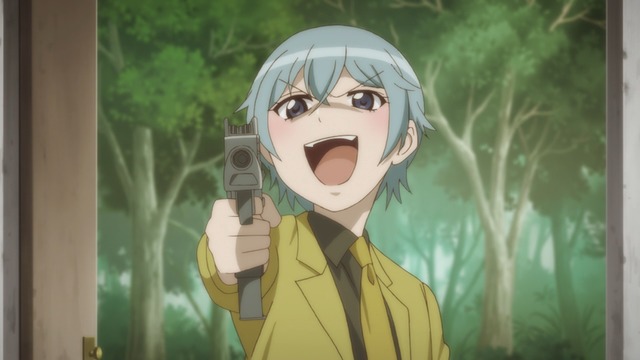
Traitorous otaku.
It's natural to compare Sabagebu! with Tokurei Sochi Dantai Stella Jo-Gakuin Kōtō-ka C³ because both shows are ostensibly about airsoft survival games, but they're really quite different. Sabagebu! basically makes no effort to adhere to any sense of realism. (Well, some of the firearms handling is surprisingly adept—way better than most anime.) The airsoft component in Sabagebu! is merely an excuse for peculiar gun antics in an otherwise shoujo (well, sort of shoujo) comedy. C3-bu, on the other hand, was perhaps a bit too realistic. It accurately reflected some of the real concerns and faults encountered within the airsoft community. Sabagebu! doesn't care about any of that. Sabagebu! is just an excuse for teenage girls to shoot their frenemies in the face as blood splatters freely. As free as a burning brassiere. (There's more blood in each episode of Sabagebu! than in two cours of Noir.)
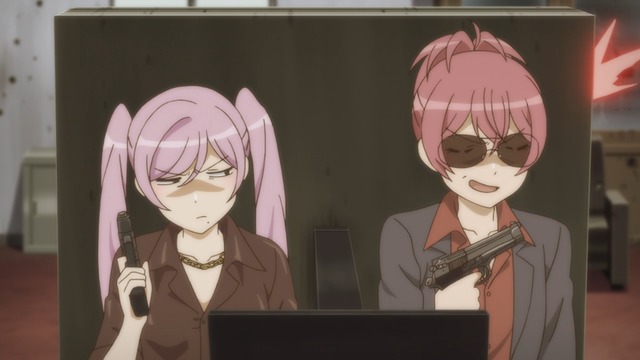
An important consideration when purchasing furniture is ensuring it is bulletproof.
With its "imaginary" firefights, Sabagebu! is more like Upotte!! because it depicts reckless gunplay and sharp acts of violence without repercussions. (The Sabagebu! girls get back up and resume bitching each other out after dying.) Really, shooting each other in the face is hardly the worst thing the Sabagebu! characters do to each other. Although the Sabagebu! anime deviates from the manga, it remains true to the spirit of shoujo in the sense that there is real cruelty in these friendships and rivalries. Considering that teasing other girls into developing eating disorders is an accepted way to reshuffle a girl's social pecking order, the inconvenience of waiting to re-spawn after taking a bullet to the noggin is fairly insignificant.
Note 1: In re Sword Art Online II: We'll see if the Sword Art Online II anime fixes the mistakes made by the original light novels regarding the Colt 1911 grip safety.
Note 2: In re C3-bu: For example, characters in C3-bu observed real world meatspace codes of conduct and standards of fairness that rang true with veteran airsoft players. Likewise, the story arc involving Yura's growing competitive streak crowding out her ability to simply enjoy herself was portrayed accurately enough to take a lot of the fun out of the episodes themselves for viewers with distasteful memories of the same.
Posted in Sabagebu!, Tokurei Sochi Dantai Stella Jo-Gakuin Kōtō-ka C3-Bu, Upotte!! | Tags: Girls With Guns, Season Introduction, Shoujo, Summer 2014, Yui Horie | Permanent Link
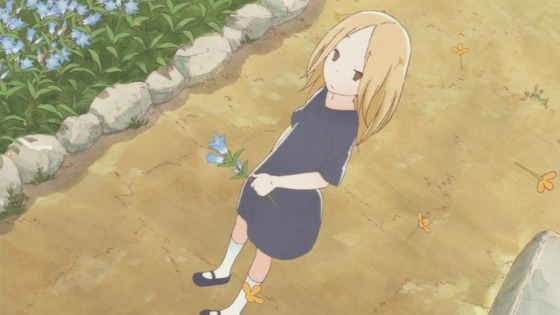
Daikichi's first impression of Rin is a recurring image.
Usagi Drop was one of the best shows from summer 2011, losing the top spot in my rankings only because of its brief 11-episode length. However, based on the outcry the original manga created, the anime's short run was its saving grace, due to the unspeakable horror of the manga's conclusion. Or so it goes.
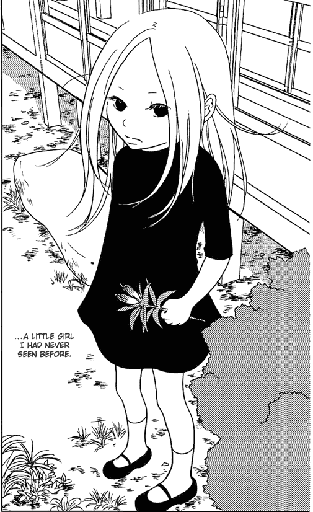
Daikichi sees Rin for the first time, manga version.
I've long learned of the otaku penchant for gross overreaction, so I took the time to read the entire manga myself—something I suspected many of its critics neglected to do. Based on my findings, I can understand why so many otaku reacted the way they did, but I personally had no issues with the manga's ending myself, possibly because I'm much less critical of anime and manga in general; I at least try not to group things into only two categories—AWESOME and HORRIBLE—there is a lot of stuff in that middle ground I enjoy, even if I don't necessarily enjoy all of it.

Here, the Usagi Drop anime ends.
The 11 Usagi Drop anime episodes duplicate the first 25 chapters of the 56-chapter manga almost scene for scene. The anime is very faithful to the source material. The anime also ends where it does because of the manga's timeskip. That's right, more than half of the Usagi Drop story occurs after the timeskip, so arguably the latter half is the "real" story which the first part merely sets up. At a minimum, a truculent reader should at least grudgingly acknowledge the second half is intended to be as important as the first half.
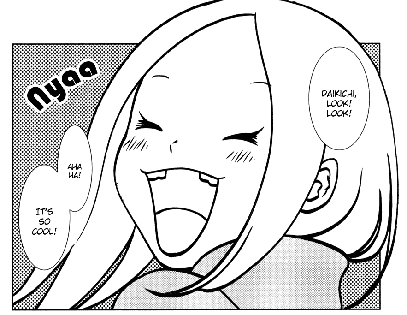
Here, the Usagi Drop manga is merely beginning.
Spoiler Warning: I won't explicitly discuss the manga events, but most readers will probably be able to easily guess the spoilers from context with little effort. When I first heard about the post-timeskip outrage, I compiled a mental list of likely spoilers based on what I knew about otaku and what I knew about Japan and what I had seen in other anime and manga. Sure enough, this list of possible rage-inducing outcomes included two of the spoilers that actually occurred in the manga, although to be fair, I was incorrect about a material detail about one of them and the one I was 100% correct on was the one I had already intuited from a scene in the anime before I had even heard about the entire controversy.
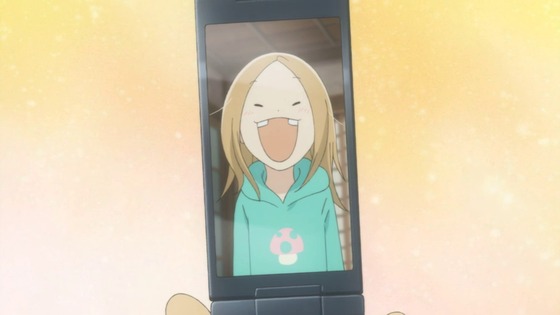
Rin shows off her missing teeth.
So why so much hostility towards the manga's ending? Frankly, I attribute it to one (or both) of two reasons. One, otaku might not be exposed to much western literature and theater if they spend most of their free time voraciously consuming manga and anime. Thus, their expectations as to what is appropriate or acceptable follow different conventions. Two, these conventions themselves are tailored in self-perpetuating otaku-friendly ways to be non-threatening. Yeah, most people angered by the Kannagi ex-boyfriend revelation were joking, but notice how none of the K-On! girls are permitted boyfriends either; even a supporting character requires plausible deniability—even in jest—when she is shown with a possible beau. This is not to say that strangers to manga and anime would not revile the Usagi Drop manga ending, but it's possible those with greater exposure to a variety of "acceptable" endings may give the title more latitude because they are more liberal with their expectations. Expectations are probably key here. For example, because its audience has different expectations, nobody bats an eye when Oedipus has sex with his mother and later puts out his eyes, and nobody cares when a Shakespeare tragedy concludes with a half-dozen dead bodies on the stage. And how many readers of the popular A Song of Ice and Fire fantasy novels are offended by all the rape, incest, and teenage brides?

Tiny pictures are the way of love.
I do not claim it is improper for manga and anime fans to hold different expectations for these works, but I do feel that those embracing narrower allowances contribute to the apparently collective overreaction to the Usagi Drop ending. And I do think they overreacted, especially the ones who were offended by second- or third-hand reports about how it played out instead of investigating the matter themselves. I can understand not wanting to "stain" a cherished impression created by the first half of the story, but someone forcing himself to look away to avoid something he's predetermined to condemn as distasteful strikes me as amusingly immature.
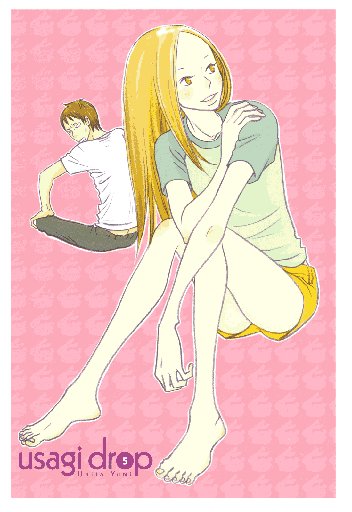
I forgot to mention timeskip Rin has legs that go up to her neck.
Yes, it turns out most of Usagi Drop is a teen drama, but it's not a bad teen drama unless you claim all teen dramas are bad as a matter of general principle. Guess what? After the timeskip, Rin is a teenage girl. And, like I said, since there are more chapters with Rin as a teenager than there are of Rin as a small child, Usagi Drop arguably is a teen drama. And it's not one of those teen dramas where nothing happens. There's kissing! There's sex! There's pregnancy! But there is also devotion and unrequited love.
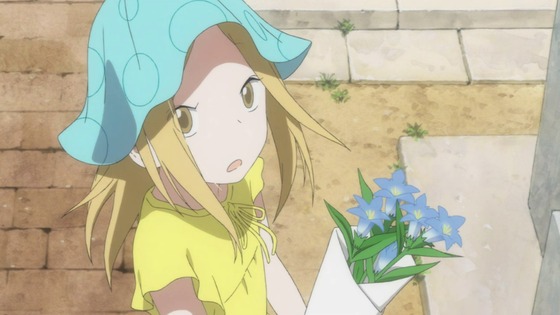
Rin pays her respects.
Frankly, none of this would even be possible were it not for two key elements established in the first half. First, Rin explicitly rejects Daikichi as a father when he broaches the subject. Second, six-year-old Rin is the sweetest, nicest, most well-mannered little girl in history, so Daikichi's parenting—as far as we are shown—consists almost entirely of having a job and being able to sign contracts. Instruction and discipline? Not so much.
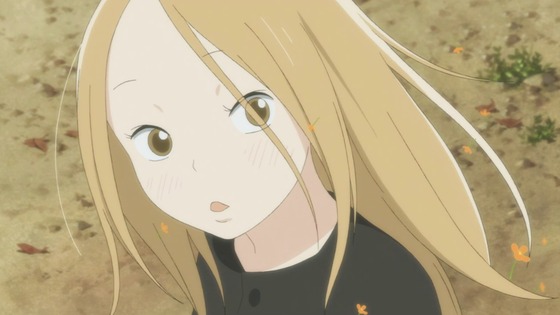
Daikichi remembers how he met Rin.
We also don't see much parenting with regard to Kouki. We know he needed more of it, since he was apparently quite a hellion, but Usagi Drop omits a lot of details. There are at least three really big incidents that occurred between the two arcs, but aside from oblique references to them, the reader remains entirely ignorant as to, you know, what happened.
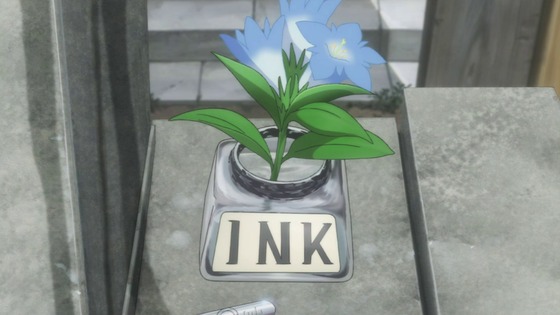
Rin's mother pays her respects.
I've probably said too much already, and if you can't figure out what the big deal is by now, you probably either don't know anything about Usagi Drop to begin with, or you weren't paying attention. If you have figured it out and still refuse to read the manga yourself because you're afraid of tarnishing the image formed by the anime, at least consider this: The first half of Usagi Drop is told from Daikichi's point of view. The second half is from Rin's and Kouki's points of view. This change is what makes the ending work for me.
Posted in Manga, RECOMMENDATIONS, Usagi Drop | Tags: 16-year-old love interests, Childhood Friend, Legs that go up to her neck, Manga, Shoujo, Summer 2011, Tiny Pictures Are the Way of Love, Unrequited Love | Permanent Link
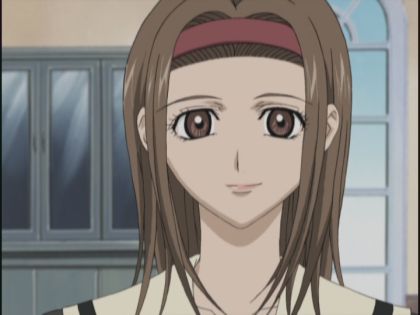
Most of the time you can't even tell Eriko is insane.
The second season of Maria-sama ga Miteru feels like two separate seasons. Just as most of the first season of Marimite is dedicated to Sei—by far the Best Girl of the entire franchise—so too is the first half of the second season. Well, except for that one episode where you find out Eriko is actually AWESOME. And also CRAZY. And definitely not a LESBIAN.
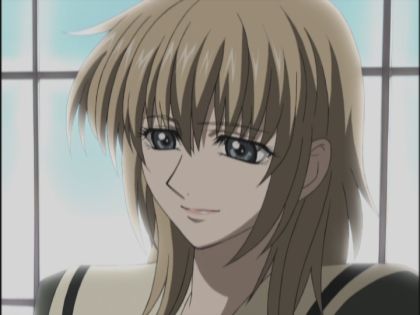
Sei reflects on her time in high school.
Sei is especially important to Marimite because she plays the senpai role to Yumi's kouhai so well. Maria-sama ga Miteru is very much about the Lillian Academy's grande sœur and petite sœur system, but it is actually Yumi and Sei's kouhai/senpai relationship through the first two seasons that establishes the show and permits it to grow during seasons three and four, not the imouto/onee-sama relationship Yumi shares with Sachiko.
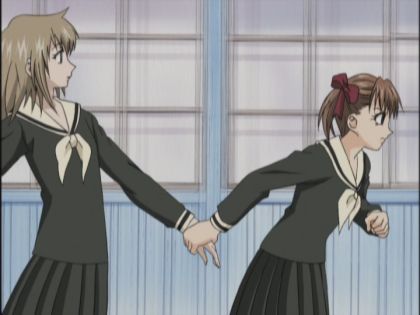
Yumi finds out Sei fucked with her again.
Anyway, the first half of season two is dedicated to Sei, but the second half (the start of Yumi's middle year in high school) is dedicated to Yumi and Sachiko. Oh, and that witch Touko. Nevertheless, Sei plays a critical role towards the end of the season when she does something for Yumi that nobody else could—something Sei can do only because she spent one-and-a-half seasons fucking with Yumi. It is, perhaps, the high point of Marimite—the zenith where its real stories about love, trust, and dedication combine to culminate in the series' finest moment. Sei earns her -sama.
Posted in BEST GIRL, Maria-sama ga Miteru | Tags: All-Time Babes, Shoujo | Permanent Link
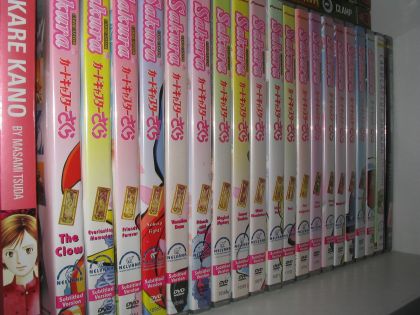
Just so you know, the shoujo rack has grown
considerably since this 2005 picture.
I've been re-watching Cardcaptor Sakura courtesy of some Blu-ray rips. Despite being relatively low-bitrate re-encodes, these Blu-rips do look better than my official Pioneer/Geneon region one DVDs. Well, at least they look better than what I remember—I haven't done a side-by-side comparison. The frame jitter is gone at least.
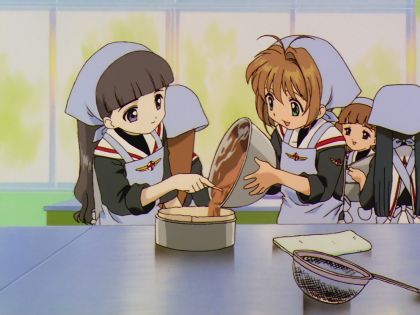
Sakura is actually one of the most powerful magikal
girls even though she sometimes fights harmless
enemies that make cakes too sweet.
Visual quality aside, the most notable difference is the remixed 5.1 surround sound audio. I suppose it is a little gimmicky, to tell you the truth, but I still enjoy being surprised by the multi-channel changes. Cardcaptor Sakura remains an excellent show that has aged very well, so I find myself caught up in its storytelling and charm instead of spending my time watching for technical changes; thus, the occasional rear-channel sound effects and such continue to catch me by surprise, even 30 episodes deep into 70-episode re-watching project.
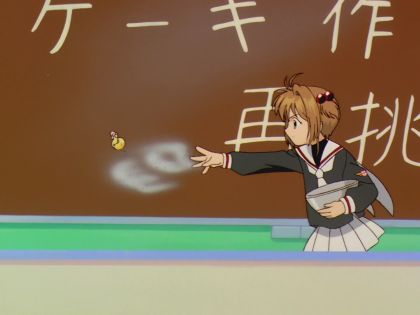
On a related note, I heard that if you put
salt on a bird's tail it won't be able to fly.
Now if we could only get the Blu-ray discs released properly over here with English subtitles at a price point below that of the otaku-bleeding Haruhi discs. I'd also prefer it if the American-market discs were not all jacked up in some exasperatingly incompetent way, too, thanks.
Posted in Cardcaptor Sakura, Loot | Tags: DVDs and Blu-ray discs, Mahou Shoujo, Shoujo | Permanent Link

Weren't you in Hyakko, Sawako?
My interest in Kimi ni Todoke originates entirely from a 95-second preview. Before that, I did not even give it a second glance when perusing the many Autumn 2009 season previews.
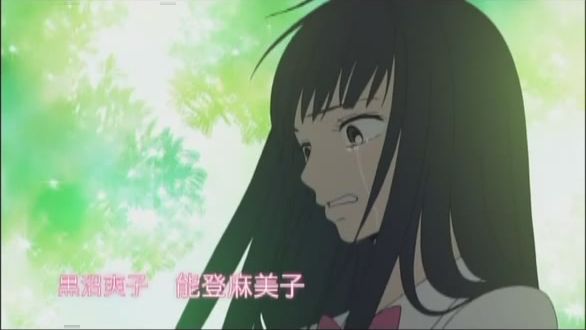
Sawako doesn't look that scary.
Moreover, I would not have watched the preview had I not been cued by the fansubbing group's name: Mamiko. Curiosity piqued, I was sold on the show within seconds.

Ringu meets Lovely Complex?
Mamiko Noto voicing the lead character in what appears to be essentially Ringu*Com sounds good enough to me. With Kimi ni Todoke, the second season of Nogizaka Haruka no Himitsu, and the second season of Queen's Blade, Autumn 2009 appears to be shaping up to be a MAMIKORE season.
Posted in Kimi ni Todoke, Nogizaka Haruka no Himitsu, Queen's Blade | Tags: Autumn 2009, Hair, Mamikore, Shoujo | Permanent Link
I finally figured out what to do with my Lillian Academy cell phone charms that RightStuf gave me with my Maria-sama ga Miteru pre-orders. (My phone doesn't have a charm hole.) Behold! Marimite USB flash drive charms.
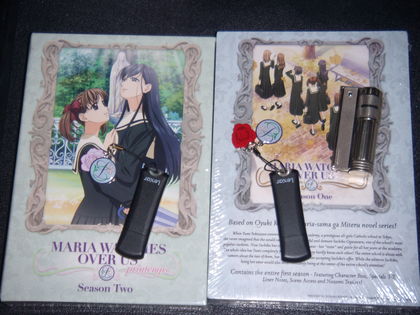
Marimite DVDs, Lillian Academy cell phone charms, and my Reki-type lighter.
Yeah, they do look fruity as all Hell.
Also pictured for no reason is my Austrian Imco lighter, which is sure to be the envy of all true Haibane Renmei fans, even if they don't smoke. Unfortunately, contrary to true Haibane fashion, I was not able to acquire it secondhand.
Posted in Haibane Renmei, Loot, Maria-sama ga Miteru | Tags: Shoujo | Permanent Link
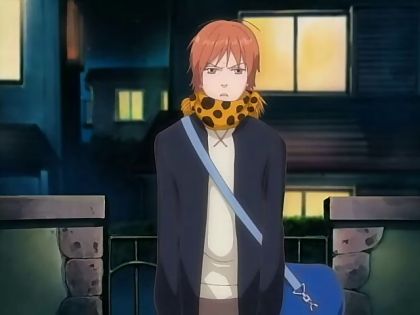
Otani may be short as Hell, but he makes
up for it with deplorable fashion sense.
Now that I've finished Lovely Complex, I'd like to add a couple of notes. First, I was a little surprised that the entire show is told from Koizumi's point of view. Pretty much up until just past the halfway point, I was expecting it to switch to Otani's point of view for at least a little bit. I should have caught on quicker considering that Lovely Complex is shoujo.
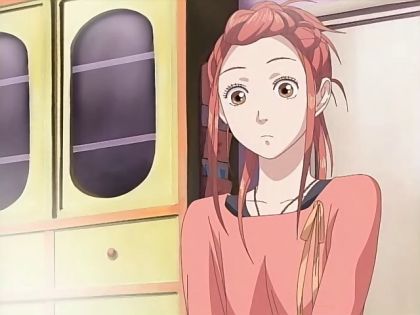
Koizumi Risa.
Second, as further testament to just how good Lovely Complex is, both Koizumi and Otani are fairly flawed individuals. They make stupid, adolescent mistakes, and press their luck pretty often. And even though I don't especially like either Koizumi or Otani, I still want things to work out for them.
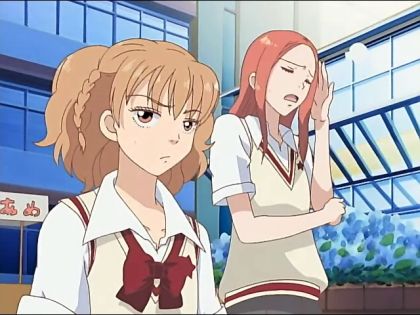
Otani's obtuseness confounds Nobu and Risa.
Most anime romantic comedies aren't good enough to maintain viewer interest without making at least one the leads (typically the female), as endearing as possible. I suppose it's intended to trigger some manner of vicarious interest in the outcome or whatnot. However, Lovely Complex has me cheering for Koizumi even though I've no interest in her (or Otani, for that matter) myself.
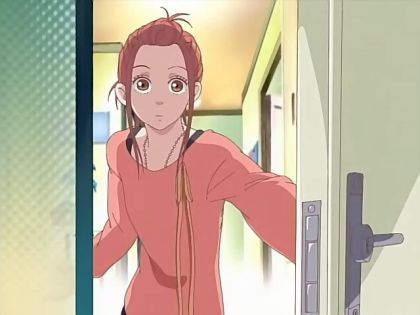
Koizumi gets a surprise.
As a matter of fact, as far as the characters go, Koizumi's preternaturally insightful friend Nobuko is probably my favorite. Her relationship advice is always so spot-on, it's uncanny. Likewise, her dedication to ensuring that Koizumi and Otani DON'T FUCK THINGS UP makes her role in their relationship invaluable. Nobu is a testament to the influence a mutual friend can have in preventing a couple from SCREWING THINGS UP ROYAL.
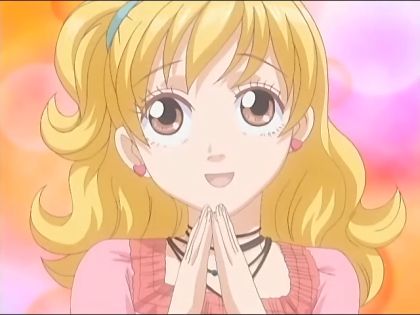
You gotta watch out for Seiko.
I'm inclined the dislike Seiko on principle, and also because of an unearthly annoying voice, but I am amused by the character's intense, over-the-top vapidness, and under-explored camaraderie with Haruka.
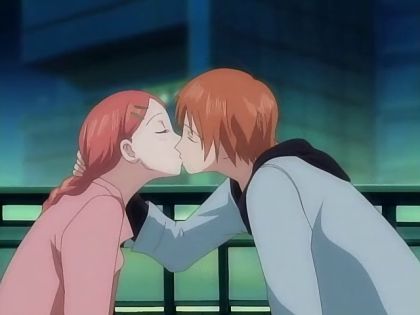
Koizumi and Otani. Uh, spoilers, I guess.
I'm sad to see the show end, because it is one of the few series out there with a perfect streak of No Bad Episodes. I'll probably end up buying the manga, since I hear there's additional material that didn't make it into the anime. It's going to be a long wait with only two English volumes in print so far, though. As it is, I'll probably end up sating my relationship-anime jonesing by re-watching Honey and Clover or Banner of the Stars. Neither of them are nearly shoujo enough to replace Lovely Complex, but I'll take what I can get.
Posted in Lovely Complex | Tags: Legs that go up to her neck, No Bad Episodes, Plying Girls, Shoujo | Permanent Link
|
|



